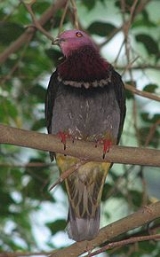
Pink-headed Fruit Dove
Encyclopedia
The Pink-headed Fruit Dove, (Ptilinopus porphyreus) also known as Pink-necked Fruit Dove or Temminck's Fruit Pigeon, is a small colourful dove
.
The Pink-headed Fruit Dove is a resident breeding endemic
bird
in Indonesia
where it occurs in the mountain forests of Sumatra
, Java and Bali
at altitudes of 1000–2200 m. It builds a flimsy nest in a tree and lays one or sometimes two white eggs which are incubated for 20 days to hatching, with a further 15–16 days to fledging. It is a shy and inconspicuous species, generally seen singly or in pairs, but flocks of up to 17 birds may form at favoured fruit trees.
The male has a purple-pink head, neck and throat, bordered below with a white band outlined in greenish black. The upperparts are green and the underparts grey, with yellow undertail coverts. The iris is orange, the bill is greenish, and feet are pink. The female is duller than the male, with a weaker breast band, and the juvenile is an even drabber version of the female. The call is a soft hoo.
This dove feeds on figs, small fruit and berries in the upper canopy of the forest, where it is well-camouflaged amongst the green foliage.
The Pink-headed Fruit Dove is restricted to less than 12,000 km² of forest in three sites on Sumatra, sixteen on Java and one on Bali, always on forested mountains at least 2000m high. Most sites are smaller than 200 km² and shrinking. However the species is very inconspicuous and it is not yet thought to be threatened.
The Pink-headed Fruit Dove is evaluated as Least Concern on the IUCN Red List
of Threatened Species.
Dove
Pigeons and doves constitute the bird family Columbidae within the order Columbiformes, which include some 300 species of near passerines. In general terms "dove" and "pigeon" are used somewhat interchangeably...
.
The Pink-headed Fruit Dove is a resident breeding endemic
Endemism in birds
An endemic bird area is a region of the world that contains two or more restricted-range species, while a "secondary area" contains one or more restricted-range species. Both terms were devised by Birdlife International....
bird
Bird
Birds are feathered, winged, bipedal, endothermic , egg-laying, vertebrate animals. Around 10,000 living species and 188 families makes them the most speciose class of tetrapod vertebrates. They inhabit ecosystems across the globe, from the Arctic to the Antarctic. Extant birds range in size from...
in Indonesia
Indonesia
Indonesia , officially the Republic of Indonesia , is a country in Southeast Asia and Oceania. Indonesia is an archipelago comprising approximately 13,000 islands. It has 33 provinces with over 238 million people, and is the world's fourth most populous country. Indonesia is a republic, with an...
where it occurs in the mountain forests of Sumatra
Sumatra
Sumatra is an island in western Indonesia, westernmost of the Sunda Islands. It is the largest island entirely in Indonesia , and the sixth largest island in the world at 473,481 km2 with a population of 50,365,538...
, Java and Bali
Bali
Bali is an Indonesian island located in the westernmost end of the Lesser Sunda Islands, lying between Java to the west and Lombok to the east...
at altitudes of 1000–2200 m. It builds a flimsy nest in a tree and lays one or sometimes two white eggs which are incubated for 20 days to hatching, with a further 15–16 days to fledging. It is a shy and inconspicuous species, generally seen singly or in pairs, but flocks of up to 17 birds may form at favoured fruit trees.
The male has a purple-pink head, neck and throat, bordered below with a white band outlined in greenish black. The upperparts are green and the underparts grey, with yellow undertail coverts. The iris is orange, the bill is greenish, and feet are pink. The female is duller than the male, with a weaker breast band, and the juvenile is an even drabber version of the female. The call is a soft hoo.
This dove feeds on figs, small fruit and berries in the upper canopy of the forest, where it is well-camouflaged amongst the green foliage.
The Pink-headed Fruit Dove is restricted to less than 12,000 km² of forest in three sites on Sumatra, sixteen on Java and one on Bali, always on forested mountains at least 2000m high. Most sites are smaller than 200 km² and shrinking. However the species is very inconspicuous and it is not yet thought to be threatened.
The Pink-headed Fruit Dove is evaluated as Least Concern on the IUCN Red List
IUCN Red List
The IUCN Red List of Threatened Species , founded in 1963, is the world's most comprehensive inventory of the global conservation status of biological species. The International Union for Conservation of Nature is the world's main authority on the conservation status of species...
of Threatened Species.

